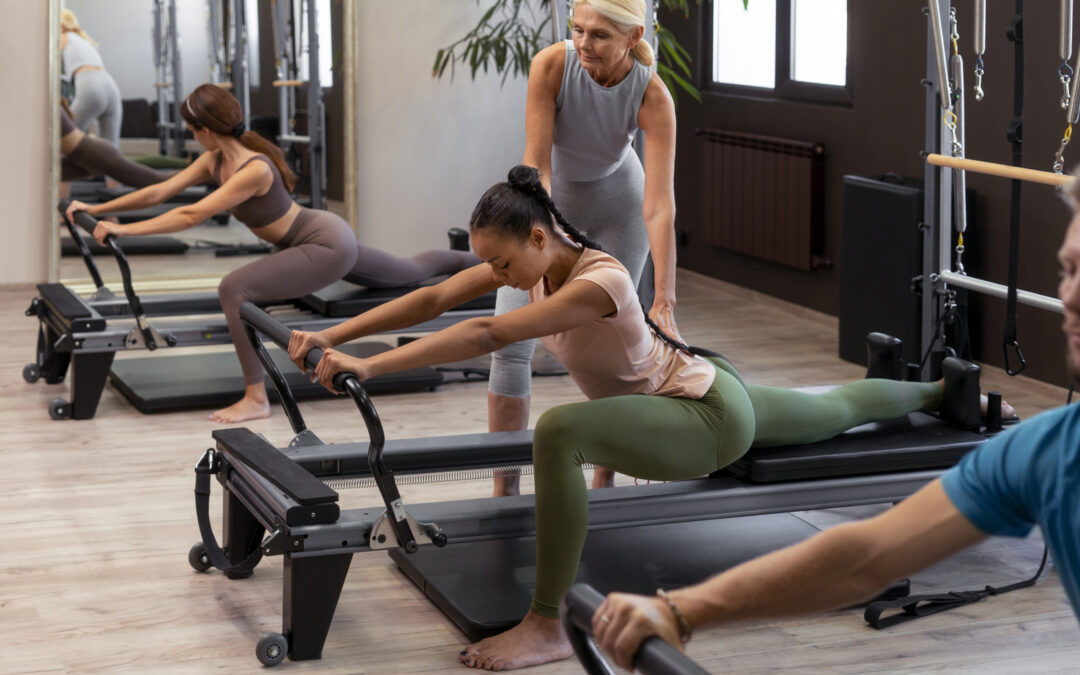Long days in a chair take a toll. Necks feel tight. Hips feel stuck. A steady Pilates routine helps, as it builds strength with care. It restores smooth motion without pounding on your joints. This guide focuses on posture, core, and flexibility. Here is how consistency can pay off:
What is Pilates good for
Pilates is good for core support. It helps you stand tall with less strain. It improves comfortable range. It steadies balance, helps protect joints with low impact work, and even supports back care. It teaches focused breath. Gains carry into daily life and sport.
1. Core strength that carries into daily life
You train deep support across the trunk. Your center holds while your arms or legs move. Groceries feel lighter. Stairs feel simple. Sessions use precise load so your spine stays cared for. Home pilates can reinforce this with short mat work between studio visits.
2. Upright posture with less neck and back strain
Practice teaches a tall position without tension. Your ribs learn to sit over the pelvis, and the head learns to sit over the chest. Screens pull the head forward, so pilates brings it back over the body with clear cues. Desk work feels easier. Driving feels better.
3. Movement without strain
You build length while you keep control. Springs guide a safe path on the reformer. Bodyweight work does the same on the mat. Hips open, while your shoulders move through clean arcs. You feel space without forcing big stretches.
4. Balanced strength that lowers common strains
Whole body patterns share the load. One area stops doing all the work. Overuse settles down. Knees track better. Hips feel centered in motion. Daily tasks feel smooth again.
5. Joint friendly training
You work hard without jumps. The carriage glides. Springs match your current strength. Pressure on knees and hips stays low. This suits people with old injuries and it also suits anyone who wants steady progress without flare ups.
6. Better balance and coordination
Pilates wakes up small stabilizers. You feel steady on single leg work. Footwork trains clear pressure through the whole foot, so stairs feel sure and turns feel controlled. Walking on uneven ground finally feels safe.
7. Back care support
Targeted core work steadies the spine. Endurance builds through smart progressions. Many clients report fewer bad days when they keep a regular schedule. Movements stay in a pain free range. Our instructors adjust springs and ranges to fit your body that day.
8. Breath that helps you focus
You pair each rep with clear breath, feel your neck tension ease as the jaw releases. Breath supports the trunk from the inside. Focus improves. Stress drops as the session moves on.
9. Support for bone health and fall risk in older adults
Progressive resistance builds strength with care. Sessions include weight bearing in many positions. Postural muscles grow strong. Gait improves. Better balance can cut fall risk. Daily chores feel safe again.
10. Carryover to sport and daily tasks
Pilates builds movement. Golf swings feel smooth. Pickleball feels snappy off the line. Gardening feels doable. The method teaches the body to move as one unit. That helps in the studio and outside it.
Pilates Q&A: Everything You Need to Know
How soon will I notice posture changes
Many people feel relief through the neck and upper back within weeks. Sessions stay consistent. Cues stay simple. Results build session by session.
Is Pilates enough to build a strong core
Yes. It targets deep support and larger movers through full body patterns. Load comes from springs or bodyweight.
Can Pilates improve flexibility without big stretches
Yes. You move through safe ranges. You keep support the whole time. Tight areas open at a pace that feels right. No forcing. No yanking.
Is Pilates helpful for a history of back pain
It can help with the right guidance. Sessions focus on support first. Movements hold a pain free range. Progress builds from there.
How would Suncoast Pilates get me started
Begin with a private or a small intro. Your instructor sets springs to match your current strength. You learn simple patterns. You add sessions at a pace that fits your week. Home pilates can support progress between visits.
How often should I train for steady results
Two sessions per week work well for most people. One session can help if your schedule is tight. Add a short home session when you can. Consistency matters most.

